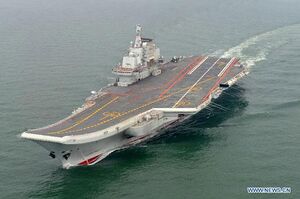Vengeance-class aircraft carrier
This article is incomplete because it is pending further input from participants, or it is a work-in-progress by one author. Please comment on this article's talk page to share your input, comments and questions. Note: To contribute to this article, you may need to seek help from the author(s) of this page. |
 GCNS Judgement transiting the Zheng Mou Sea in 2008
| |
| Class overview | |
|---|---|
| Name: | Vengeance-class aircraft carrier |
| Builders: | Dalian Shipbuilding & Marine Engineering |
| Operators: |
|
| Built: | 1980-1992 |
| In service: | 1984-present |
| Planned: | 3 |
| Completed: | 3 |
| Active: | 3 |
| General characteristics | |
| Type: | Aircraft carrier |
| Displacement: |
|
| Length: |
|
| Beam: |
|
| Draft: | 11 m (36 ft 1 inch) |
| Decks: | 14,700 square metres |
| Installed power: | 2 x Fushan Atomics CV2 nuclear reactors each producing 125,000 shp, total 250,000 shp (186 MW) |
| Propulsion: | 4 x shafts driving 5-bladed, fixed pitch propellers |
| Speed: | 30+ knots (56 km/h) |
| Range: | Unlimited |
| Endurance: | 120 days |
| Armament: |
|
| Aircraft carried: | Up to 80 fixed and rotary wing aircraft |
| Aviation facilities: |
|
Design
General characteristics
Vengeance class aircraft carriers measure 296 m (971 ft) long at the waterline and 320 m (1050 ft) overall, with a beam of 39 m (128 ft) at the waterline. At full load, they have a displacement of approximately 85,000 metric tonnes and a draft of 11 m (36 ft 1 inch). The ships have a complement of 3000 sailors, 2100 air crew
Power and propulsion
The Vengeance class carriers are powered by two CV1 pressurised water reactors (PWR), which are each housed in separate compartments. The nuclear reactors were developed and built by Fushan Atomics, based upon a prototype design constructed and trialled at the Naval Nuclear Power Laboratory. CV1 PWRs are equipped with a core of highly enriched (over 93%) uranium-235 and are capable of generating 450 MW of thermal energy via nuclear fission, which translates into a steam output of approximately 430 metric tonnes of steam at a temperature of over 315 °C (588 K) per hour. This steam is then passed through four turbines cross linked to both reactors on each ship to produce a total of 121 MW of electricity, as well as 65,000 shp (48.5 MW) for each of a Vengeance class' four propeller shafts. Steam is also diverted for use in each carrier's two steam catapults.
The GCN's official figures for the Vengeance class' maximum speed state only "in excess of 30 knots", with the actual top speed being classified. However, with their powertrain's output being known at 260,000 shp (193.9 MW) across four shafts from public domain sources, it is unofficially suggested that their top speed is in the range of 32 knots. As a result of their nuclear powerplants, the carriers are capable of continuous cruising at their top speeds for extended periods of time- the CV1 reactors were designed for an expected lifespan of 20 years before refuelling was required.
Armour and protection
While largely protected by their escorts, defensive weaponry and countermeasures, the Vengeance class also feature passive design features which maximise their survivability against enemy attack. These include damage control features, but also compartmentalisation and armour. While exact details are classified, the Vengeance class are known to have been constructed with up to 50 mm of Kevlar armour over vital spaces such as the weapons magazines, aviation fuel storage tanks, propulsive machinery and nuclear reactors for protection against spalling and shrapnel. The carriers were also built with an armoured flight deck, side armour within the hangars and blast-resistant bulkheads